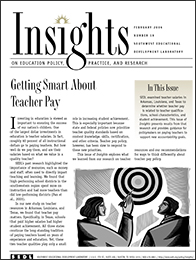Getting Smart About Teacher Pay
Introduction
In This Issue
SEDL examined teacher salaries in Arkansas, Louisiana, and Texas to determine whether teacher pay is related to teacher qualifications, school characteristics, and student achievement. This issue of Insights presents results from that research and provides guidance for policymakers on paying teachers to support new accountability goals.
Investing in education is viewed as important to ensuring the success of our nation’s children. One of the largest dollar investments in education is teacher salaries. In fact, roughly 60 percent of all instructional dollars go to paying teachers. But how well do we pay them, and are their salaries based on what we value in a quality teacher?
SEDL’s past research highlighted the importance of resources, such as money and staff, often used to directly impact teaching and learning. We found that high-performing school districts in the southwestern region spent more on instruction and had more teachers than did low-performing districts (Pan et al., 2003).
In our new study on teacher resources in Arkansas, Louisiana, and Texas, we found that teacher pay matters. Specifically, in Texas, schools that paid higher salaries had higher student achievement. All three states continue the long-standing tradition of paying teachers based on years of experience and education. Yet, these two teacher qualities play only a small role in increasing student achievement. This is especially important because state and federal policies now prioritize teacher quality standards based on content knowledge, skills, certification, and other criteria. Teacher pay policy, however, has been slow to respond to these new priorities.
This issue of Insights explores what we learned from our research on teacher resources and our recommendations for ways to think differently about teacher pay policy.

Next Page: Education and Experience: Primary Drivers of Pay

